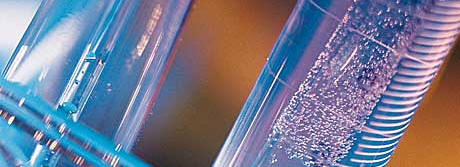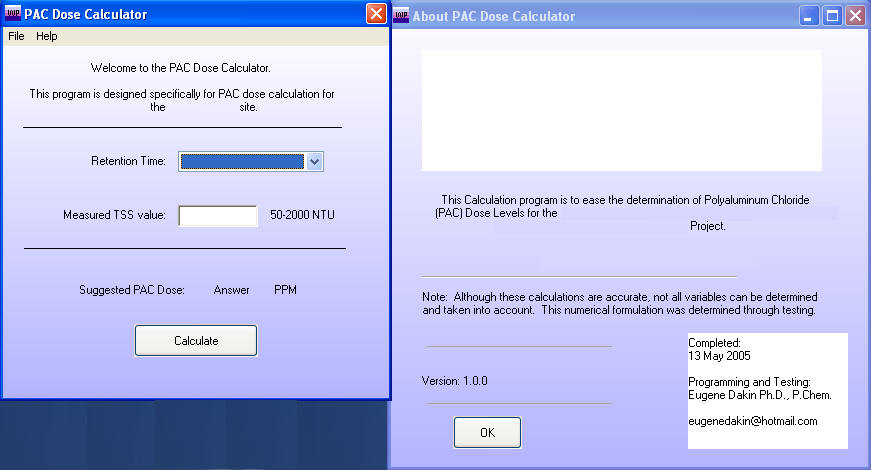
|
Eugene Dakin Ph.D., P.Chem Professional Chemist |
|
|
|
|
Water Chemistry There are three generalized areas of water involvement: 1) Oilfield Water, 2) Wastewater, and 3) Potable water. A computer program has been developed for a certain aspect of Wastewater treatment. The computer screenshot is viewed at the bottom of this page. Potable Water (Waste Water is after this section. Scroll down for more information) Potable water is commonly known as 'municipal water' or 'drinking water' that comes out of your faucet at home. Water from rivers and lakes are treated with various chemicals to make it clear and healthy to drink. Common terms for treating water are: Flocculation, Chlorination, Fluorination, Taste and Odour Removal and Filtration. This specialized area of chemistry employs many chemists and chemical technologists. Potable water typically meets criteria defined by test methods distributed by the American Water Works Association (AWWA), American Public Health Association (APHA), and the Water Environment Federation (WEF). High standards are in place to ensure that public safety is the first priority. Almost all required test methods are available and can be found when searching the internet for 'Standard Methods for the Examination of Water and Wastewater'. Further branches of this area ensure a high quality of supply of treatment chemicals and products. Similarly, this is another area where chemists and chemical technologists are employed. A typical potable water treatment plant will have the following treatment steps: A) Water intake from the middle-centre of a river stream B) Bulk filtration C) Flocculation D) Rapid mixing E) Settling F) Decanting G) Microbe neutralization H) Fine filtration I) Fluorination
Description of steps
A) Water intake from the middle-centre of a river stream When water is removed from the middle (equal distance from each bank) and the centre (equal distance from the river bottom and top), it is typically the cleanest. Cleaner water requires less treatment (time and chemical) than dirty water.
B) Bulk filtration It is here that the large debris is removed from the water. Debris usually consists of trees, rocks and other undesirables.
C) Flocculation Flocculants remove the fine dirt and other materials that gives drinking water its clear, colourless appearance. Flocculants attach themselves to many dirt particles, which increases their mass.
D) Rapid mixing This necessary step is needed to facilitate equal distribution of the flocculent in the water.
E) Settling After the rapid mixing step is complete, the water forms large flocs, which drift to the bottom of the settling pond.
F) Decanting The clear water on top, is removed from the settled flocs, which are now called sludge.
G) Microbe neutralization Although the water has a pleasant clear, colourless appearance, it may not be safe to drink due to the microorganisms present. A biocide such as chlorine is added to neutralize the organisms.
H) Fine filtration Fine filtration uses other chemicals to remove the organisms, taste, odour, and fine particulates from the water. The water is ready to drink at this stage.
I) Fluorination Some municipalities add a small amount of fluoride to promote healthy teeth and bone formation.
Many successful variations of these steps exist for each treatment operation. A general rule-of-thumb is that each person in a town or city will use 650 litres per day.
Waste Water
Waste Water is commonly known as Sewage water, disturbed water, or process water that has been contaminated with some form of material (sewage, dirt, sand, or other undesirable material) Common terms for treating water are: Flocculation, organic neutralization, Biological Oxygen Demand (BOD) loading, Total Suspended Solids (TSS), Total Dissolved Solids (TDS), and many other parameters defined by municipalities and other regulatory bodies such as the Department of Fisheries and Oceans (DFO). This specialized area of chemistry employs many chemists and chemical technologists. Potable water typically meets criteria defined by test methods distributed by the American Water Works Association (AWWA), American Public Health Association (APHA), and the Water Environment Federation (WEF). High standards are in place to ensure that public safety is the first priority. Almost all required test methods are available and can be found when searching the internet for 'Standard Methods for the Examination of Water and Wastewater'. Further branches of this area ensure a high quality of supply of treatment chemicals and products. Similarly, this is another area where chemists and chemical technologists are employed. A typical waste water treatment plant will have the following treatment steps: A) Water Collection B) Bulk filtration C) Flocculation D) Rapid mixing E) Settling F) Decanting G) Microbe neutralization H) Fine Filtration I) Phosphate Removal (Aerobic and Anaerobic) J) Sulphur Removal (Aerobic and Anaerobic) K) Water Ejection
A) Water collection When water is collected from a source. This could be from the sewers of a city, or could be disturbed water in a construction zone.
B) Bulk filtration It is here that the large debris is removed from the water. Debris usually consists of trees, rocks and other undesirables.
C) Flocculation Flocculants remove the fine dirt and other materials that gives drinking water its clear, colourless appearance. Flocculants attach themselves to many dirt particles, which increases their mass.
D) Rapid mixing This necessary step is needed to facilitate equal distribution of the flocculent in the water.
E) Settling After the rapid mixing step is complete, the water forms large flocs, which drift to the bottom of the settling pond.
F) Decanting The clear water on top, is removed from the settled flocs, which are now called sludge.
G) Microbe neutralization Although the water has a pleasant clear, colourless appearance, it may not be safe to other life forms due to the microorganisms or other contamination present. A biocide such as chlorine or Ultra Violet lamps are used to neutralize the organisms.
H) Fine filtration Fine filtration uses other chemicals to remove organisms and fine particulates from the water. The water is almost ready to be ejected into the river at this stage.
I) Phosphate Removal Some municipalities require the removal of phosphates from water to meet current provincial guidelines. This is usually performed in multiple steps in various aerobic and anaerobic chambers.
J) Sulphur Removal Some municipalities require the removal of Sulphur from water to meet current provincial guidelines. This is usually performed in multiple steps in various aerobic and anaerobic chambers.
K) Water Ejection Once water meets all criteria and guidelines, it can be safely ejected into the river.
The following Screenshot displays a computer program designed for a consulting company to calculate the appropriate dose of a water treatment chemical.
Appropriate information has been removed to protect current contracts and agreements with applicable companies.
|
|
| © 2006 - Eugene Dakin -
|

